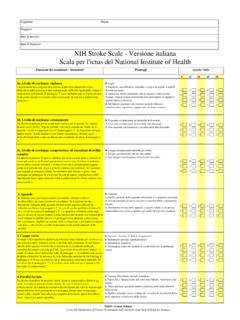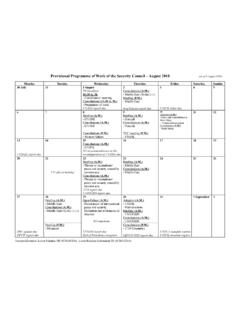Transcription of MAPPING GLOBAL VALUE CHAINS - OECD.org - …
1 MAPPING GLOBAL VALUE CHAINS For Official Use TAD/TC/WP/RD(2012)9 Organisation de Coop ration et de D veloppement conomiques Organisation for Economic Co-operation and Development 03-Dec-2012 _____English - Or. English TRADE AND AGRICULTURE DIRECTORATE TRADE COMMITTEE Working Party of the Trade Committee MAPPING GLOBAL VALUE CHAINS 4-5 December 2012 The OECD Conference Centre, Paris Action required: The report TAD/TC/WP(2012)6 has been updated and revised following comments received at the 21-22 March 2012 meeting of the Working Party of the Trade Committee and 27 April meeting of the Working Party on the Globalisation of Industry. The document includes the latest data available from the OECD ICIO model (December 2012 release).
2 A follow-up study on the trade policy implications of GLOBAL VALUE CHAINS was scoped in June [TAD/TC/WP(2012)11/REV1]. The report is submitted FOR DECLASSIFICATION. Link to the Programme of Work and Budget: This work falls under PWB Section , Understanding the Benefits of Globalisation. Co-operation: The work is done jointly with STI and the Working Party on the Globalisation of Industry, and in co-operation with STD and STI, as part of the horizontal project on the measurement of trade in VALUE -added terms. Communication plans: The report and results will be presented in a series of conferences and seminars on GLOBAL VALUE CHAINS and their implications for trade policy. Contact: S bastien Miroudot (TAD), Tel. +33 (0)1 45 24 13 94, Email: Koen De Backer (STI), Tel.
3 +33 (0)1 45 24 76 61, Email: JT03332194 Complete document available on OLIS in its original format This document and any map included herein are without prejudice to the status of or sovereignty over any territory, to the delimitation of international frontiers and boundaries and to the name of any territory, city or area. TAD/TC/WP/RD(2012)9 For Official Use English - Or. English TAD/TC/WP/RD(2012)9 2 TABLE OF CONTENTS EXECUTIVE SUMMARY .. 4 MAPPING GLOBAL VALUE CHAINS .. 7 1. Introduction: the rise of GLOBAL VALUE CHAINS .. 7 2. Data and 10 New data available to study GVCs: the OECD ICIO model .. 11 Measuring the importance of GVCs: country and industry indicators .. 11 3. Analysis of specific GVCs .. 16 Case study 1: agriculture and food products.
4 16 Case study 2: chemical products .. 20 Case study 3: motor vehicles .. 23 Case study 4: electronics (office, accounting and computing machinery) .. 27 Case study 5: business services .. 29 Case study 6: financial services .. 34 4. Policy implications: closing the gap between policies and the reality of business .. 37 REFERENCES .. 39 ANNEX 1: INDICATORS ON GLOBAL VALUE CHAINS .. 42 Figures Figure 1. GVC participation index in OECD countries (2008) .. 12 Figure 2. GVC participation index for selected non-OECD economies, 2008 .. 13 Figure 3. Average length of GVCs across all industries .. 14 Figure 4. Length of GVCs by industry, 2008 .. 15 Figure 5. Distance to final demand, by economy, 1995 and 2008 .. 16 Figure 6. The Nutella GLOBAL VALUE chain .. 17 Figure 7.
5 Length index Agriculture (2008) .. 18 Figure 8. Length index Food products (2008) .. 18 Figure 9. Participation and distance to final demand Agriculture (2008) .. 19 Figure 10. Participation and distance to final demand Food products (2008) .. 20 Figure 11. The chemicals VALUE chain .. 21 Figure 12. Length index Chemicals (2008) .. 22 Figure 13. Participation and distance to final demand Chemicals (2008) .. 22 Figure 14. Import content of exports by country of origin, motor vehicles industry (2005) .. 23 Figure 15. Length index Motor vehicles industry (2008) .. 24 Figure 16. Participation and distance to final demand Motor vehicles industry (2008) .. 25 Figure 17. Vertical trade in the motor vehicles industry (2008-09) .. 26 Figure 18. Length index Electronics (2008).
6 27 Figure 19. Participation and distance to final demand Electronics (2008) .. 28 Figure 20. Vertical trade in the electronics industry (2008-2009) .. 29 TAD/TC/WP/RD(2012)9 3 Figure 21. Trade in business services, as a share of total trade in services (2000-08) .. 30 Figure 22. The business services VALUE chain .. 31 Figure 23. Length index Computer services (2008) .. 32 Figure 24. Length index Other business services (2008) .. 32 Figure 25. Participation and distance to final demand Computer services (2008) .. 33 Figure 26. Participation and distance to final demand Other business services (2008) .. 34 Figure 27. The banking and finance VALUE chain .. 35 Figure 28. Length index Financial services (2008) .. 36 Figure 29. Participation and distance to final demand Financial services (2008).
7 37 TAD/TC/WP/RD(2012)9 4 EXECUTIVE SUMMARY World trade and production are increasingly structured around GLOBAL VALUE CHAINS (GVCs). A VALUE chain identifies the full range of activities that firms undertake to bring a product or a service from its conception to its end use by final consumers. Technological progress, cost, access to resources and markets and trade policy reforms have facilitated the geographical fragmentation of production processes across the globe according to the comparative advantage of the locations. This international fragmentation of production is a powerful source of increased efficiency and firm competitiveness. Today, more than half of world manufactured imports are intermediate goods (primary goods, parts and components, and semi-finished products), and more than 70 percent of world services imports are intermediate services.
8 The emergence of GVCs during the last two decades has implications for the impact of trade and investment barriers both on the country implementing the measures and on the GLOBAL economy. However, these implications are not yet fully understood given the fact that the empirical evidence on GVCs remains limited. The last years have witnessed a growing number of case studies on the globally integrated VALUE chain at the product level, but of course these analyses only depict the situation for that specific product. More aggregate evidence has also been developed in order to get a more comprehensive picture of GVCs. The OECD, in co-operation with the WTO, has developed estimates of trade flows in VALUE -added terms. Inter-country input-output tables and a full matrix of bilateral trade flows are used to derive data on the VALUE added by each country in the VALUE chain , thus giving a better picture of trade flows related to activities of firms in GVCs.
9 The main objective of this paper is to provide for more and better evidence allowing to examine the position of countries within international production networks. The paper develops a number of indicators that give a more accurate picture of the integration and position of countries in GVCs. It also provides a more detailed assessment of GLOBAL VALUE CHAINS in six broad industries: agriculture and food products, chemicals, electrical and computing machinery, motor vehicles, business services and financial services. Since these indicators have been derived using the OECD inter-country input-output model, they are estimates that can be re-assessed in the future when the model is updated. The GVC participation index indicates the extent to which a country is involved in a vertically fragmented production process (in relative and absolute terms).
10 The index of the number of production stages shows how long GLOBAL VALUE CHAINS are and also highlights the domestic and international part of the VALUE chain . Lastly, the distance to final demand points out the upstreamness of countries and their position in the VALUE chain . The collection of these different indicators at the country and industry level reveals the following stylised facts: Even at the aggregate level, empirical data on trade and output confirm the fragmentation of production and the emergence of GLOBAL VALUE CHAINS . Recent indicators introduced in the literature give a better understanding of the depth of the phenomenon. On average more than half of the VALUE of exports is made up of products traded in the context of GLOBAL VALUE CHAINS .













